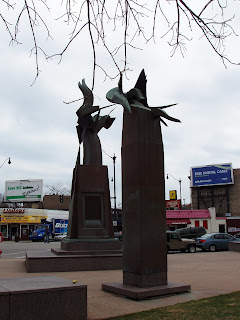



Done by Richard Hunt, these forms are located in Jonquil Park, a small neighborhood park at 1023 West Wrightwood Avenue, at the junction of Lincoln, Sheffield and Wrightwood. Near his studio. According to Mr. Artner, Hunt has more monumental art on view here than any other Chicagoan.
These pieces posed a problem for me. While I liked them, I did not like them there. Personally, I think they should be where the "Reading Cones" are. Because the busy-ness of the neighborhood businesses in the background detract mightily.

You just cannot get a really good angle from which to appreciate them. And I'm not sure even which way they face. If north, then you have to stand across the street to view them, if south, then you should cross the park. But not from close up, unless you like craning your neck.


Yes, I liked them, beautiful forms evoking eagles and flight and soaring freedom. But not there. As you will see, from the pictures. They are quite impressive and somehow, spiritual, and deserve a better location.
 I have included so many pics so you can see just what the problem is.
I have included so many pics so you can see just what the problem is.
























